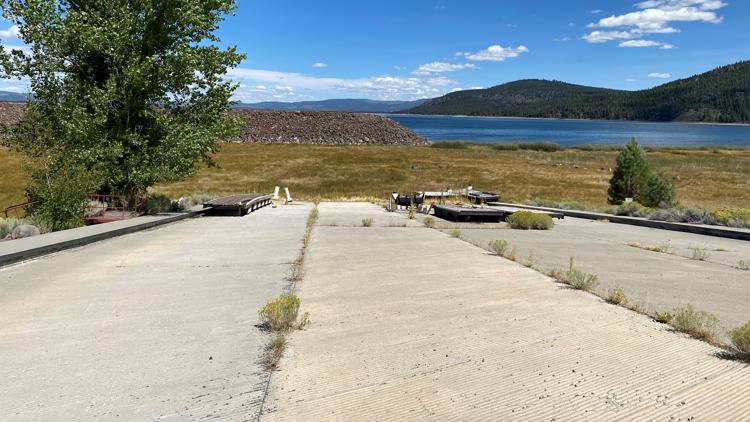LASSEN COUNTY, Calif. — A combination of warmer climate and water mismanagement has led to the draining of Eagle Lake near Susanville.
While changes could still be made to preserve what’s left, the Bureau of Land Management says getting the lake levels to where they were a century ago would take decades of rain without evaporation — and that’s a scenario that just won’t play out.
Evaporation and winds drop lake levels at Eagle Lake several feet every year.
“You get 3-5 feet of loss every year so you have to balance that with recharge, and if you don't, then the lake just gets smaller and smaller,” said Stan Bales with the Bureau of Land Management.
Recharging the lake with water is difficult. Eagle Lake sits on the leeward side of the lower Cascade Mountain Range. It’s what’s considered the rain shadow side of a mountain where precipitation hits the area, but it’s not nearly as much as the windward side. You might consider it the leftover rain from a storm. Filling the lake becomes harder due to the smaller rain and snow totals.
“Fredonyer Peak up there is almost 8,000 (feet) and it holds snow nicely, but it's a short run," said Bales.
Eagle Lake is a closed lake basin. There is only one surface source for runoff and it comes from Pine Creek.
Adding to the lake’s dropping levels was the Bly Tunnel. In the 1920s, Leon Bly headed the tunnel project in hopes to bring water from Eagle Lake to the neighboring Honey Lake Valley for agriculture needs.
“The intent was to take Eagle Lake water, increase the flow of Willow Creek, then divert it in Honey Lake Valley and then sell the water through a canal system to farmers, ranchers and try and make money doing that,” said Bales.
Little did they know the water was highly alkaline and not suitable for crops.
“They didn't sell enough water to make money to pay off their debts, and so they went out of business. Bankruptcy," said Bales.
Eagle Lake, and surrounding Susanville and Lassen, are made of volcanic rock. The rock puts a lot of alkalinity in the water leaving the pH balance too high for certain crops to absorb nutrients and grow.
“Because that tunnel did drain a lot of water out of Eagle Lake, the lake got much lower and some people who loved Eagle Lake were not happy with that tunnel operation,” said Bales.
Eventually, a concrete plug was installed with a valve. An argument over water rights was filed by land owners and only a small amount of water was released.
“It became a hot topic in the last six to eight years because the lake continued to drop during the drought, and people felt like that plug was allowing the water to drain and lower the lake. Eventually our BLM manager agreed to shut the valve on that plug,” said Bales.
What used to be a booming lake full of campers and fisherman is now limited to the south side of the lake. The Bureau of Land Management says the water quality from the middle to north sides of the lake were hit the hardest. Algae now grows in shallow water on the northside and is spreading across the lake.
Paul Divine with the California Department of Fish and Wildlife says the algae is impacting many of the water activities.
“That’s been really noticeable, especially with anglers, because they complain about the algae being caught on their lines and they have to reel their stuff in and clean it off before they can catch a fish," said Divine.
Much of the shoreline on the northside has receded tremendously. The beauty and uniqueness of Eagle Lake has not gone unnoticed. Conservation strategies are underway to save the Eagle Lake Trout.
“From the 1900s-1960s, maybe there is 11 different species of fish planted into Eagle Lake and none of them have survived to today, so we only have the native fish,” said Divine.
According to the California Department of Fish and Wildlife, Eagle Lake Trout are genetically adapted to the high alkalinity and warmer temperatures of the lake, so much so they have been used in other California lakes to bring recreation to fisherman, but have also been shipped as far off as New Zealand.
Creel surveys are being conducted to help maintain the fish population at Eagle Lake.
“It's the habits of the fish, what they might be eating that day or changes in the weather, phases the moon. There's all kinds of things you can look at and relate to changes in the feeding behavior of the fish,” said Divine.
A fish hatchery at Eagle Lake helps maintain a healthy population. It’s a start to saving Eagle Lake, but now others are looking into how to further save what’s left.
Valerie Aubrey has devoted her life to Eagle Lake.
“(It’s) been my heart and soul since birth,” said Aubrey.
Aubrey worked as a fishing tour guide for more than 20 years and is a member of the nonprofit Eagle Lake Guardians. Aubrey blogs about the issues plaguing the once vibrant lake.
“With the drought, the water changing and such, we have very warm water. You know, last time I checked it, I had 70.8 (degrees) to 30 feet,” said Aubrey.
Eagle Lake trout are known to survive in 70-degree water and find pockets of cooler water to settle in, explains Divine.
She hopes recreation activities like ATV and bike riding could keep the economy thriving, if fishing and camping don't boost visitors.
The lake is expected to continue dropping until major snow storms or runoffs empty into it.
WATCH MORE ON ABC10 | Tiny threat, big impact: invasive snails thrive in Lake Tahoe





















